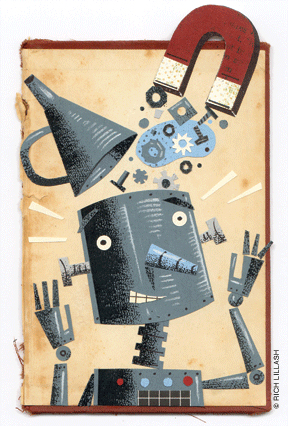
Magnets for the Blues
Major depression strikes about 17 million Americans every year. For roughly a third of them, neither medication nor psychotherapy works. But a new finding indicates that some of these patients may benefit from an unorthodox treatment: magnetic fields.
In the largest study of its kind, researchers led by Dr. John P. O’Reardon, associate professor of psychiatry at Penn, tested a treatment called transcranial magnetic stimulation (TMS) on depressed patients for whom other therapies had failed. TMS is a non-invasive technique that passes magnetic pulses through the scalp to excite neurons in the brain.
In a double-blind experiment reported in a December issue of the journal Biological Psychiatry, about 15 percent of the subjects receiving TMS five times a week went into remission within 6 weeks—twice as many as from a control group that underwent a sham therapy. Moreover, there were no serious side effects and the dropout rate was substantially lower than is typical for patients on anti-depressant medications.
Whistling While They Work
When it comes to picking stocks, any analyst worth his pinstripes knows to pay attention to a company’s price-to-earnings ratio, revenue growth, and a host of other quantitative measures. Satisfied customers are also key—but what about satisfied employees? According to a recent paper by Wharton finance professor Alex Edmans, that is one intangible that traders overlook—to their own detriment.
Working from Fortune magazine’s annual list of the “100 Best Companies to Work for in America,” Edmans found that, since 1998, the stock returns of companies with high employee satisfaction have been more than double those of the overall market. What’s more, he didn’t start measuring share performance until a couple weeks after the list’s publication—giving traders plenty of time to react to the information.
But evidently Wall Street has been more likely to ignore the value added by happy employees. Adherence to conventional wisdom may be the reason. “Traditional management theory,” Edmans says, “treats workers like any other input—get as much out of them as possible and pay them as little as you can get away with.” But if stock performance is any measure—and ultimately it’s the only one—companies that treat their workers as well as they can get away with may have the edge.
Engineering Nerve Tissue
A year after pulling off the feat with rats, researchers at the School of Medicine have developed a laboratory technique for making miniature nervous systems from human neurons. Using mechanical tension to stimulate the growth of long nerve fibers, known as axons, the team managed to turn living nerve cells into jellyfish-like structures of nerve tissue that may one day be used to repair spinal-cord injuries and other nerve damage. These engineered networks survived and retained their essential function for at least three months, the scientists reported in the Journal of Neurosurgery.
Senior author Douglas Smith, professor of neurosurgery and director of Penn’s Center for Brain Injury and Repair, says that this answers a key challenge in the tricky business of nerve transplantation—namely, where to get nerve tissue and how to keep it healthy.
“There’s a cluster of a neurons called the ganglion that’s just right outside your spinal cord, that a really simple procedure can go in and take out … so you could be your own donor,” he says. “We can [also] get millions upon millions of neurons from an organ donor and grow them in culture the same way, and really have something that’s off-the-shelf transplant material.”
—T.P.

